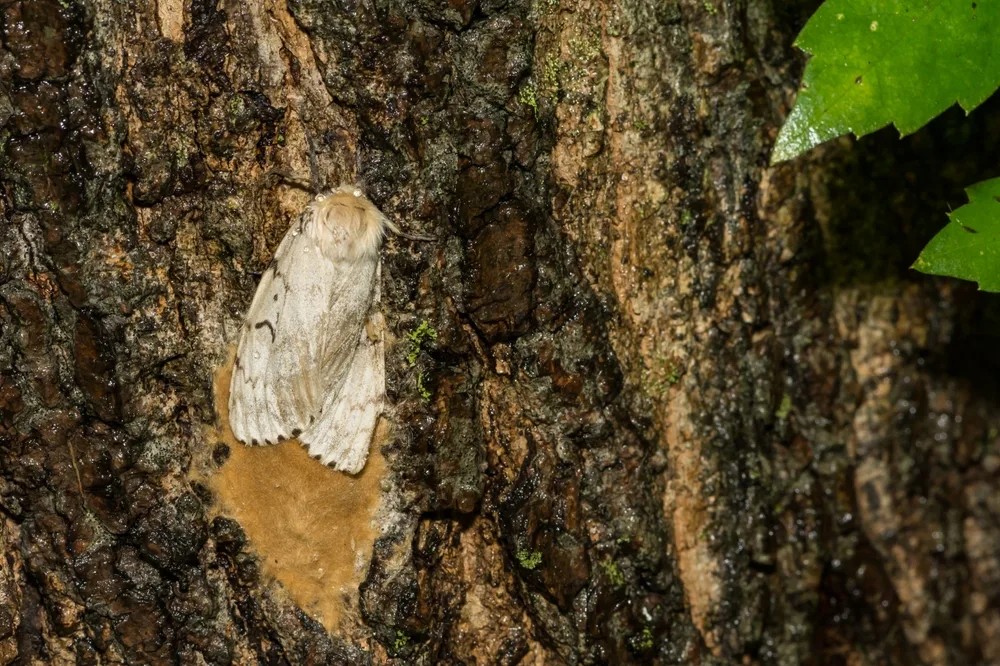The spongy moth (Lymantria dispar), formerly called the gypsy moth, is an invasive insect brought to the U.S. from France in 1869 for silk production.
This moth has been causing significant damage to forests and backyards approximately every 10 years since its introduction. If you notice that your oak trees, one of the spongy moth’s favorite plants, are losing leaves, start looking for signs right away.
Identifying Spongy Moth Activity

It’s easier to manage an infestation when the caterpillars have come down from the tree canopy.
Once they hatch and mature, they eat tree leaves at night and rest during the day, often on your home, tree trunks, and vehicles. You can physically trap, remove, and destroy them.
Using Chemicals and Professional Help
A chemical spray can be used safely, or you might need to call in professional help. Sometimes, you can let nature take its course.
A spongy moth caterpillar outbreak can seem sudden. One mid-July morning, you might wake up to find half of your favorite tree’s leaves gone and fuzzy caterpillars all over your yard.
Early Detection
Signs of their presence can be seen the summer before, when adult moths mate and lay egg masses. If you can find and destroy the egg masses before they hatch, you can avoid a lot of trouble.
Managing an infestation is easier when the caterpillars have come down from the canopy.
Physical Removal
Once they hatch and mature, they eat tree leaves at night and move down to rest during the day, where you might see them on your home, tree trunks, and vehicles.
You can trap, remove, and destroy them physically. If done safely, a chemical spray may also be applied.
Calling in Professionals
If necessary, you might need to call in professional help. Sometimes, you can let nature take its course.
How to Manage a Spongy Moth Infestation
The presence of spongy moths doesn’t always mean an infestation. Healthy trees can often withstand minor defoliation once a season.
However, as an invasive species, they lay eggs on cars, firewood, and almost any solid surface, spreading easily.
Creating a Burlap Trap
While isolated to one or two trees, you can make a burlap trap by tying a wide piece around the trunk. Fold the top half of the burlap down to stop their upward movement.
They rarely turn around or climb over the barrier, so you can pull them off into soapy water. Although they aren’t poisonous, wear gloves in case of allergies.
Using Insecticides
Spraying a caterpillar killer, like Bt, can quickly deal with them, but it also kills butterfly and moth caterpillars. Consider calling in help.
Using insecticides in the canopy is a job for a licensed arborist who has the equipment to reach high into the tree. Insecticides are not highly selective and will kill beneficial insects too. Think about the impact on helpful insects and animals before spraying.
Let Nature Take Its Course for Small Outbreaks
For less severe infestations, you can let nature take its course. Major infestations happen about every 10 years and last from 3 to 4 years.
Natural Remedies
Large-scale spraying is used during the worst outbreaks, but natural remedies also exist.
Fungal and viral infections of spongy moth caterpillars occur naturally during severe outbreaks.
Utilizing Natural Enemies
Nuclear polyhedrosis virus (NPV) is one of the spongy moth’s natural enemies. Caterpillars infected with this virus cling to the side of the tree, hanging in a “V” shape. Entomophaga maimaiga, a fungus from Japan, targets spongy moth larvae, harming nothing else. Infected caterpillars cling to trees with their heads hanging down. Leave diseased larvae to spread the infection.
Encouraging Birds
Turning your yard and garden into a bird haven can also help. Many birds will gladly eat spongy moth larvae.
